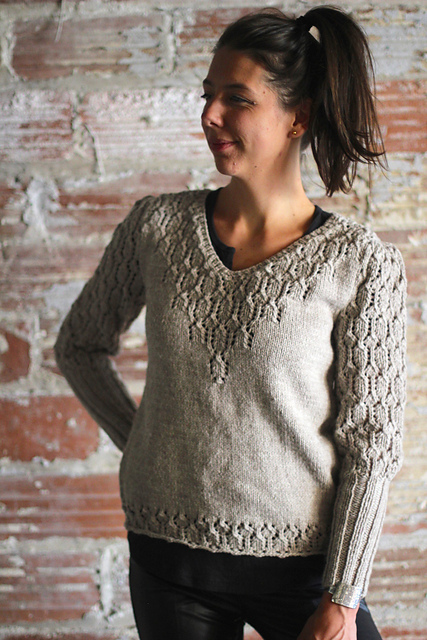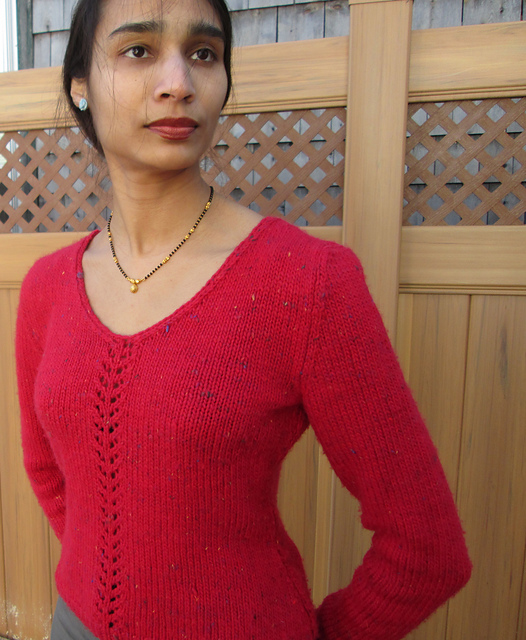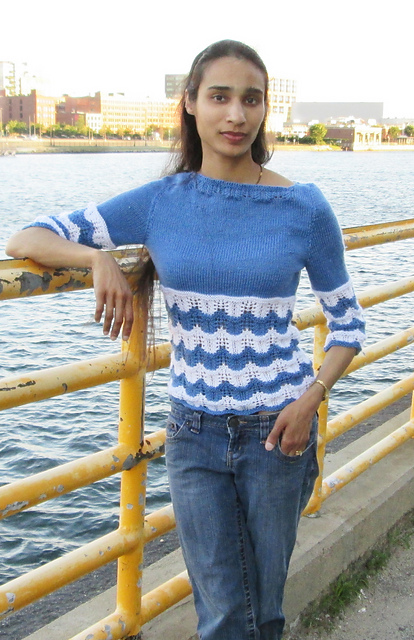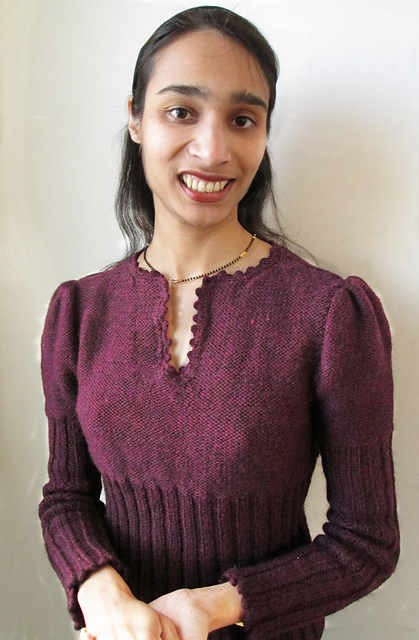I’ve admired Ashwini Jambhekar‘s work for a while. She makes interesting sweaters that a professional can wear to work, and writes thoughtful forum posts.
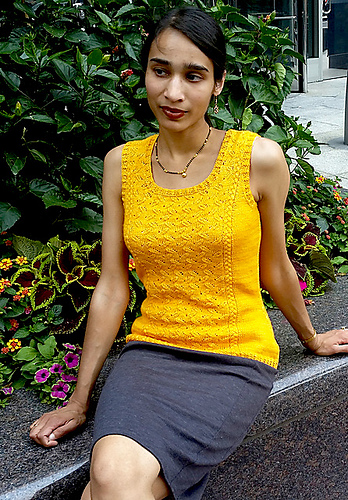
You as a designer questions:
What is your design process?
I often start with a concept or idea that I want to highlight. For example, the theme for Demeter Tank was “princess seams,” since I’d been sewing garments with prominent princess seams, and wanted to replicate the look in knit. Polonaise sweater was based on Gigot (aka “leg of mutton”) sleeves, which I thought would be quite unique now. I then did a bit of research to see what era they were from, and what sorts of bodice styles they accompanied.
What influences your style?
I don’t follow style “trends” much, but I do browse the latest sewing patterns, which are influenced by runway styles. In general, my style is influenced by my pragmatic needs (winters are cold where I live, and my job is not compatible with too many frills, flounces, flaps etc. on garments). So I try to keep the base silhouette of the garment fairly streamlined, but then add a detail that will be elegant and feminine, rather than keeping the whole piece strictly utilitarian.
What about designing and producing patterns are you most adept at, what parts are you most fond of, and what parts are challenging? (Pattern Grading, the last week of editing, coming up with a name for a project, self promotion?)
I love coming up with ideas and executing them in yarn, and also figuring out all the math. Pattern layout is something that I can do decently, but it’s not my favorite thing, so my pattern layouts are rather plain. I grew up knitting from Women’s magazines, where an entire sweater pattern fit in one column of a single page, and I think my patterns look a bit like what I learned from. I do provide more explicit instructions than the magazine patterns, though! The naming and post-publication marketing steps are definitely the most challenging for me. Even though I’ve enjoyed interacting with knitters whom I’ve met through my patterns (either as test knitters or customers), finding and reaching my audience is always difficult.
You as a Giftalong designer:
Where you surprised at how big the giftalong became?
Oh, definitely. I remember the first year just watching from the sidelines. At that time, I didn’t understand the premise, but it all became clearer when I participated the next year as a designer. Now it’s something I look forward to every year, and it’s becoming a big part of my late fall plans. It’s great to see so many people coming together to chat, encourage each other, try new things, and generally be good friends. I think that as our societies become more diverse, events like the GAL could serve as models for how to build community across age, gender, religious etc. gaps. The wide range of participants in this event has been fantastic to see.
Where you skeptical of the “abundance” ideas, or did they seem just right?
I’m not sure what you’re asking about—are you asking about the field being saturated?
What have you learned from the promotion?
I think I’ve discovered how much can be done when people work together. The organizers do a tremendous job and devote a lot of time and effort, and it definitely pays off. It’s so easy to be disillusioned by all the failed group projects that occur in all aspects of life, that the GAL serves as a great reminder of how powerful group efforts can be if done correctly.
You as someone who likes to make things questions:
What is your usual process on a fiber project, for instance, do you start with a yarn, a cute pattern, a need you’ve noticed, something exciting you saw in a movie you want to copy, or a technique you want to learn – then what do you do next and then what?
When I’m selecting a pattern to knit, I usually choose based on how much I like the design aesthetic, and whether I’ll get many opportunities to wear it. Sometimes I have stash yarn to use and try to match my project to that, but I’ve been pretty good at minimizing impulse yarn purchases, so I typically only buy yarn if I have a pattern in mind. Most of my knitting is for garments, so I’ll often start with a gauge swatch. But if I’ve worked with the yarn and needles (within a size or two) before, and have a good sense of how the yarn knits up, I might skip the swatching step. I’m taking this approach with my GAL project Adiri (by Julia Trice) since I’m using the same yarn I did for my Polonaise sweater. After swatching (or deciding not to) I dive right in and cast on!
Does anything intimidate you in knitting or crochet?
I don’t think so. It’s just a bunch of string! There are, however, certain things that just don’t interest me much, like colorwork. I’ve done a couple of pieces in the past, but I think my aesthetic tends more towards monochrome. So while I admire some of the really fancy colorwork pieces I see on Ravelry, I can’t see myself making and wearing one.
When you want to learn something, do you look it up in a book, on U-tube, or seek a real person to teach you?
I like to learn with clear photo tutorials, so I usually turn to Google to lead me to an online tutorial with static images. I find it harder to learn from videos. I also sometimes look things up in Vogue Knitting: Ultimate Knitting Book. The book approaches knitting from more of a seamstress’ perspective, which I find intellectually satisfying.
Any repetitive motion disorders due to knitting or crochet? How do you deal with them?
Fortunately, none!
Do you frequent a particular yarn store?
My LYS has a great selection of yarns, and I usually shop there. Several yarn stores sadly closed in the last few years, and I stocked up on yarn during their going out of business sales. That has kept me occupied for some time. Otherwise I often end up buying “souvenir” yarn when visiting a new place. I’ve discovered some lovely yarn stores that way.
Do you usually finish things? If not, does it bother you?
Yes, I do. I’m very much a product knitter, which means I want the FO now. I don’t like having many WIPs and it does bother me, so I try to keep to 2-3 WIPs at a time. Usually one is a small/ easy project for commuting, one is a larger/ more complex project that stays at home, and sometimes there will be a third project if I’m knitting to a deadline for a 3rd-party publication.
Do you get to do any “selfish knitting?”
Most of my knitting is selfish. I only knit the things I want, and if I’m self-publishing, the item stays with me. Many of the 3rd-party publishers return samples, and I’m fortunate to be about the same size as their models, so I can wear the sample when I get it back. Some 3rd-party publishers either have a policy not to return the samples, or to request them in a size that won’t fit me, but that’s been the exception rather than the rule.
Is knitting a seasonal activity for you?
I knit year-round! There’s something very attractive about curling up on the couch with a knitting project and a blanket in the colder months, so I tend to knit more then. But there’s still a lot of knitting happening in the summer months.
What makes you buy a pattern (lovely photo, the story of the project, it looks do-able, it looks slightly challenging…)
My pattern choices are mostly driven by the design aesthetic, and whether it looks too difficult for me to bother reverse-engineering it.
What gives you the feeling that you got your money’s worth out of a pattern?
If it makes the FO as advertised, I’m happy! I’m pretty minimalistic, and not influenced by pattern layout, formatting etc. So if the pattern is accurate, I’m pleased with it.

